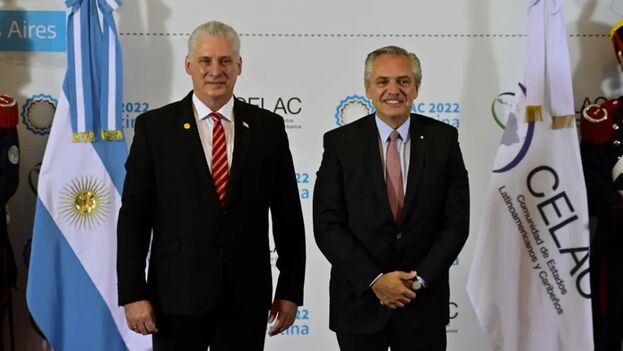
![]() 14ymedio, Madrid, February 27, 2023 — Cuba is the unexpected guest at a meeting, on March 17, between the presidents of Argentina, Mexico, Brazil and Colombia to create a product exchange mechanism with which they aspire to contain inflation. The possible agreement between four Latin American giants and the stunted Cuban economy has been revealed by Alberto Fernández himself to the Argentine economic newspaper Ámbito.
14ymedio, Madrid, February 27, 2023 — Cuba is the unexpected guest at a meeting, on March 17, between the presidents of Argentina, Mexico, Brazil and Colombia to create a product exchange mechanism with which they aspire to contain inflation. The possible agreement between four Latin American giants and the stunted Cuban economy has been revealed by Alberto Fernández himself to the Argentine economic newspaper Ámbito.
“López Obrador called me and proposed we launch an agreement with Brazil, Colombia and Cuba, which total most of the region’s GDP, to help us with a problem that is common to all of us, as is inflation,” the president said in exclusive statements to that newspaper.
The Mexican, who received Fernández on February 17, told him about the idea, which should take place next month at this summit. The idea, the Argentine advanced, is to develop a set of “sensitive” products that, if their prices skyrocket, can be imported at a lower value.
The Argentine president gave a concrete example to the newspaper and explained that, if a product such as clothing went up in price alarmingly, one could go to one of the participating countries, such as Brazil, to obtain it at a cheaper value and exchange it for a more affordable one in the country, hers, without going any further. This mechanism, Fernández defined, would be “a kind of clearing,” as commercial clearing systems are known in the economic sphere.
Alberto Fernández clarifies that, after communicating with López Obrador, he spoke with Luiz Inacio Lula Da Silva, Gustavo Petro, and Miguel Díaz-Canel to share the initiative and the meeting with them. “We also agree that in the meantime the ministers of each country would talk to each other. In my case, I instructed Santiago Cafiero (Chancellor) and Sergio Massa (Minister of Economy) to move forward with that,” he adds.
From Fernández’s words it can be inferred that the idea of adding Cuba came from Mexican president, although it is the Argentine head of state himself who, naturally, includes the Island in the group of countries that contribute most to the Gross Domestic Product to Latin America.
According to data from the Economic Commission for Latin America (ECLAC), at the end of 2021, Brazil, with 1.6 trillion dollars in GDP, is the largest economy in Latin America, followed by Mexico, with 1.3 trillion dollars. Argentina (487 billion) and Colombia (314 billion) are much lower, but Chile, left in the middle (with 317 billion), is fourth in the region.
To locate Cuba you have to go to position 27, with 2.05 billion “official dollars” that year, even well below Venezuela, which is at position 12 and without mentioning the possible presence of Nicolás Maduro at the summit. Nor, apparently, is Chile’s President Gabriel Boric, at least to date, invited to the summit. He is theoretically related to this ideological block, although distant in his positions with respect to Cuba, Nicaragua and Venezuela.
The island does compete strongly for the position of inflationary champion within that group. Although Argentina, which closed 2022 with a 94.8% price increase, seems the absolute winner even against the Island, which reported 39%. However, the informal market indicates that Cuba ended the year with increases of 140%. Far away are Colombia (13%), Brazil (5.7%) and the 7.8% of Mexico, and these figures are not insignificant.
Although Argentina has not experienced an economic situation like the current one for 32 years, the last decades have been extremely unstable for both its own and foreign causes, and the country has alternated great economic growth with bankruptcies so deep that it has been forced to suspend payments and resort to the International Monetary Fund to save itself.
Like most countries, first the pandemic and then the global crisis aggravated by the war in Ukraine have worsened the situation, and the measures taken have left the economy with contrasts, both at the macro and micro levels. Despite this, and the balances that the president must make to comply with the IMF in an election year, it is expected that it will be one of the highest growth nations in the region.
Argentina is a large net exporter of raw materials, 70% of its international trade. Cereals and oilseeds account for, in fact, around 50% of their total exports, so Fernández showed great enthusiasm around the new mechanism created by López Obrador. According to the president, the countries called to sign the agreement have a large network of food, energy and manufacturing production and, in addition, will have as an incentive the relief of not being forced to resort to the dollar as an exchange currency.
The trade between Mexico and Argentina has never been particularly active. The Mexican Ministry of Economy placed the country as the 29th largest partner in 2018, only 0.2% of total trade and sixth in the region. Just a year later, in 2019, it fell even more, to 31st place, with 1.562 billion dollars. On the other hand, bilateral trade between Cuba and Argentina currently exceeds 300 million dollars and is mainly based on raw materials and food products. In recent years, discussions have increased to form joint projects, especially in the promotion of agriculture.
Translated by Regina Anavy
____________
COLLABORATE WITH OUR WORK: The 14ymedio team is committed to practicing serious journalism that reflects Cuba’s reality in all its depth. Thank you for joining us on this long journey. We invite you to continue supporting us by becoming a member of 14ymedio now. Together we can continue transforming journalism in Cuba.
